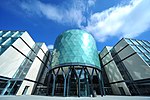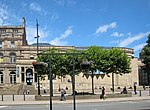Leeds Mechanics' Institute
Education in LeedsEducational institutions established in 1824Grade II* listed buildings in LeedsUnited Kingdom education stubsUse British English from December 2023 ... and 1 more
Yorkshire building and structure stubs

Leeds Mechanics' Institute was a mechanics' institute founded in 1824 in Leeds, West Yorkshire, England, and is one of the predecessor institutions of Leeds Beckett University and Leeds Arts University.
Excerpt from the Wikipedia article Leeds Mechanics' Institute (License: CC BY-SA 3.0, Authors, Images).Leeds Mechanics' Institute
Millennium Square, Leeds Woodhouse
Geographical coordinates (GPS) Address Phone number Website Nearby Places Show on map
Geographical coordinates (GPS)
| Latitude | Longitude |
|---|---|
| N 53.801666666667 ° | E -1.5469444444444 ° |
Address
Leeds City Museum
Millennium Square
LS2 8BH Leeds, Woodhouse
England, United Kingdom
Open on Google Maps










